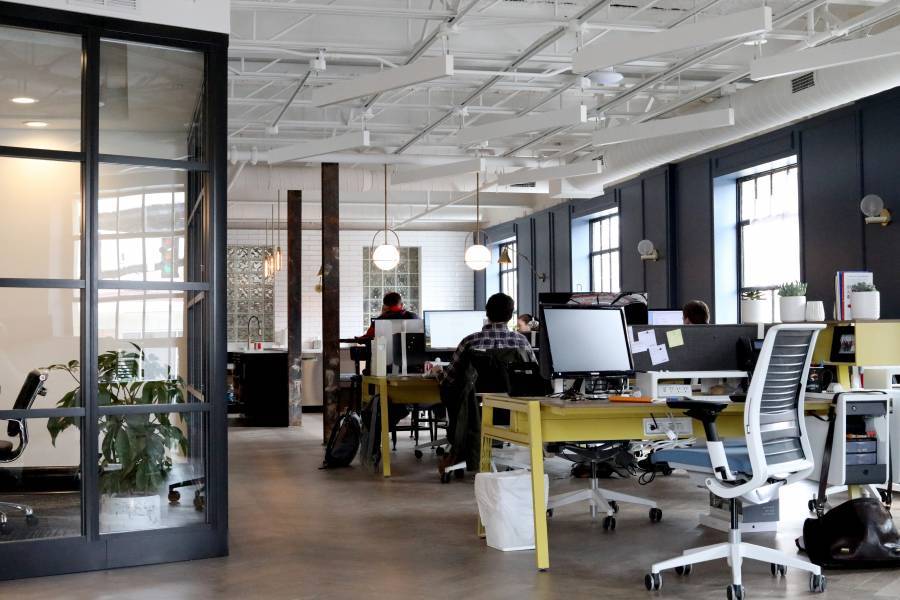Completely open workspaces might not be the norm for long if employees and productivity experts have their way. According to research conducted by William Belk, 58 percent of top performers want more privacy, and 54 percent say their current spaces have too many distractions to be truly effective.
Open designs were originally intended to increase collaboration and communication, and they did the job. But such trends in workforce environments have led to hardships for independent workers. As Jan Lehman, president of CTC Productivity, notes: “Everyone, and I mean almost everyone, needs quiet, focused time away from others. Even individuals who you might think should be collaborating all day long, like a customer service rep, need quiet time.”
Consequently, plenty of companies are backpedaling a bit and offering more workspace variety to boost productivity and decrease efficiency pain points.
Understanding the Effects of Space on Output
We’re all slaves to our surroundings, whether we want to admit it or not. Case in point: Most people have been through the jarring experience of trying to pay attention in a cluttered environment or foster creativity in a totally sterilized atmosphere.
Neither makes sense for modern workers, yet businesses consistently lean in one direction or the other. And the latter is especially painful for innovators, which is probably why adding just a few live plants to an undecorated office boosted human yield by 15 percent according to one U.K. study.
Truly, ambiance matters. Ellen Delap, certified professional organizer, frequently advises clients to take this into consideration when setting up workspaces for themselves and colleagues. “How you set up your desk, your digital desktop, your documents, and your physical space can help you be more productive,” she explains. “The aesthetics, including office color and sound, have a positive impact on well-being.”
This goes double for employees toiling away in a residential setting rather than at headquarters, Lehman chimes in. “Allowing individuals to work from home is becoming a necessary benefit in this tight job market. In addition to ensuring you have the right setup at work, many also need the same configuration at home.”
And what about technology? It turns out that some tools marketed to boost production actually do the opposite. Consider email, which Lehman cautions makes everything seem pressing. As she avers, it’s a fabulous addition to any tool kit as long as it’s not abused, which Delap sees happening all the time. “[Email is] overused for communication, overwhelming to work through, and frequently used instead of a phone call,” Delap says. “It has become a burden for most employees to get through the amount of information that arrives daily.”
A Workfront study corroborates Delap and Lehman’s beliefs, indicating that though 94 percent of workers use email, 53 percent say it can lead to wasted time, and 55 percent believe communication through email could often be better handled via phone or in-person meetings.
Of course, not all technologies lead to negative outcomes. Slack and other project management tools, for example, bypass the annoyances of emails, such as “reply all” answers and interminably long messages. But even those solutions can become irritating in a world of 24/7 access and expectations.
The answer isn’t to completely rid offices of open spaces, techno-gadgetry, or modern design, however — which would be cost-prohibitive and like throwing the proverbial baby out with the bathwater. Instead, the solution lies in tweaking layouts and operations to overcome common productivity and efficiency limitations.
Think you’ll be mired in the process of reinventing your workspace forever (or at least long enough to lose interest and stamina)? You might be surprised by how a few fast, painless changes can have significant payouts.
1. Swipe clutter from existence.
Humans aren’t meant to focus on a million things at once; they tend to lose concentration in cluttered areas. The simplest way to improve well-being, promote organization, and keep people motivated is by offering fewer visual and aural stimulations.
New to the process of downsizing your stuff? Delap promotes the use of easy-to-maintain paper and digital systems. “A simple system uses a broad base to categorize your documents. Sort into your system by triaging paper and electronic documents daily, and then file as needed. Use a capture tool, such as Evernote, or a spiral notebook to capture tasks and chunk down projects that start with information from a meeting or arrive in email.”
2. Get away from distractions.
When Amy Tokos, owner of Freshly Organized, feels overwhelmed by unnecessary noises, sights, and technologies, she sets up shop in a different location or simply shuts off her office from the rest of the world. Just taking charge helps her tackle demands without giving in to competing concentration snatchers. “An hour of focus time with no interruptions (email and phone included!) can be a game changer,” she says.
For those working at home, soundproofing or noise reduction tools are critical if other family members are around. Additionally, tools like Jabber can help remote workers indicate when they are at their desks so co-workers know they’re available.
3. Enforce boundaries.
In our always-on world, setting up boundaries can be tough. In fact, individuals have been so conditioned to respond immediately that when University of Southern California researchers tested participants’ email response times, they found that half answered in less than an hour.
This is why Lehman wants to see companies enforce policies around response time expectations for both internal and external communications during and outside of business hours. Without such boundaries, workers might lose momentum and fall into unproductive habits.
4. Use technology to your advantage.
Technology isn’t inherently good or bad; it’s how you use it that matters. Consider dual computer screens, for instance. They’re not only helpful, but they’ve also been shown to improve employee productivity by up to 30 percent per Jon Peddie Research.
Certainly, dual monitors cost a little more upfront, but they allow people to get papers off their desks without losing the ability to explore two documents simultaneously. Additionally, users don’t have to switch between tabs on one screen, which can make your digital workspace feel more cluttered.
It’s time to rethink the structure of every workplace, giving a nod to the need for both rapid communication and individual privacy. Productivity isn’t just a buzzword; it’s an objective for any business that wants to stay on the leading edge. Even minimal changes can transform a team from ineffective to super-efficient.
Try Out Productivity Tools We Are Using
Monday.com | Best Productivity and Management Tool | on Monday.com | |
Calendar.com | Best Calendar and Scheduling Tool | on Calendar.com | |
Later.com | Best Social Media Scheduling Tool | on Later.com | |
Todoist.com | Best Time Management Tool | on Todoist.com | |
Toggl.com | Best Value Tool | on Toggl.com | |
Trello.com | Best Overall Tool | on Trello.com |


























